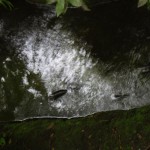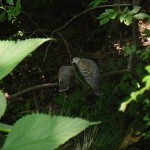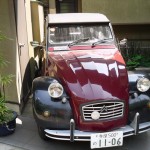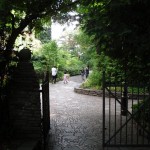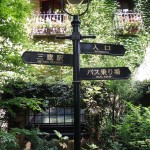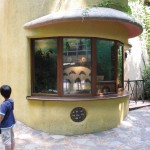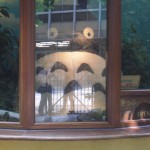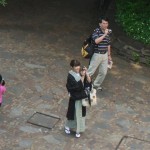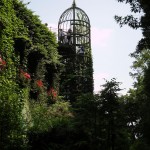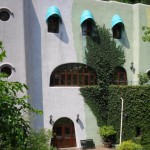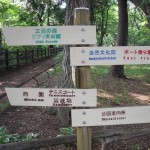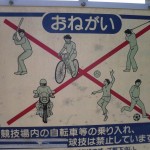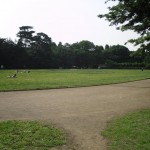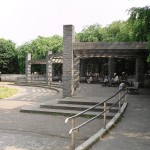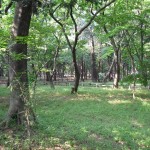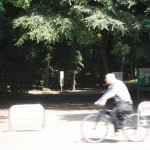I had succeeded in buying tickets to the Ghibli museum at a Lawsons convenience store with the help of the friendly staff the previous day. The Lonely planet guide book was mistaken in indicating if you hadn’t purchased your ticket months ahead of time you wouldn’t be able to go. Just point yourself to one of the many Lawsons convenience stores, look to make sure they have one of their electronic kiosk machines and then ask the person at the counter with your best broken Japanese if they can help you to purchase a ticket to the Ghibli museum.
I did this by pointing to the machine, saying Ghibli and the lady behind the counter beamed a smile and walked over to the machine to assist me. The Ghibli museum is a huge draw to many people visiting Tokyo and this left me wondering about how reliable the rest of the information found in a lonely planet book. But that’s for another post. If you’re doubting what I’m telling you just go to the Ghibli museum website where you’ll be able to confirm the above information.
Some quick information about the Ghibli museum taken from wikipedia:
“Ghibli Museum (三鷹の森ジブリ美術館, Mitaka no Mori Jiburi Bijutsukan?, Mitaka Forest Ghibli Museum) is a museum featuring the Japanese anime work of Studio Ghibli, and is located in Inokashira Park in Mitaka, a western suburb of Tokyo, Japan.
The museum is a fine arts museum, but does not take the concept of a usual fine arts museum. With many features that are child-oriented and a sprawling and occasionally mazelike interior, the museum is a playfully created place. Centered around the motto appearing on the museum’s website “Let’s become lost children together” (迷子になろうよ、いっしょに, Maigo ni narō yo, isshoni?), or ‘let’s lose our way together’ as it is translated in the English leaflet. It has no set path or order of viewing. While the museum brochure contains a variety of languages, the signs within the museum are in Japanese only.”
The Museum was co-founded by Hayao Miyazaki who many consider to be the Walt Disney of the east. Personally I think his movies are much better than Walt Disneys (not offense meant!). Many of the characters, displays and items found in the museum were directly related to his movies.
When you purchase a ticket for the Ghibli Museum you have to specify the time and date that you will be there. I believe that they do this in order to minimize having too many people in the museum at the same time. The metro ride there was a little confusing but you can take the Chuo line to reach the museum (I departed from Akihabara station; a geek/nerd heaven which wasn’t too far from the hostel where I was staying). Here’s a quick pick from the platform while I was waiting and it provides a good idea of your typical Japanese train station:
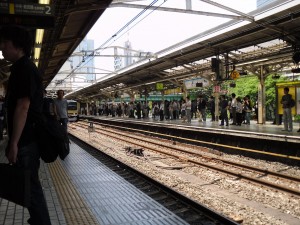
The signs to the museum were not clearly indicated in English at the Akihabara station (but you knew that right? You are in Japan after all!). I simply asked a station attendant “Ghibli Musem” while pointing at the different gate numbers. He flashed the number 5 using his hands and I was off. The confusing part was that I had to switch trains but remain on the same platform in order to continue to my destination. If you’re going to be taking the train there I suggest you give yourself some extra time in case you get lost. The Mitaka stop is a nice district and if you arrive early you can relax in the many coffee shops, grab something eat or even wander through a nice park which is only minutes away from the museum.
Once at the Mitaka station all that was required was to follow the very clearly indicated signs to Ghibli museum:
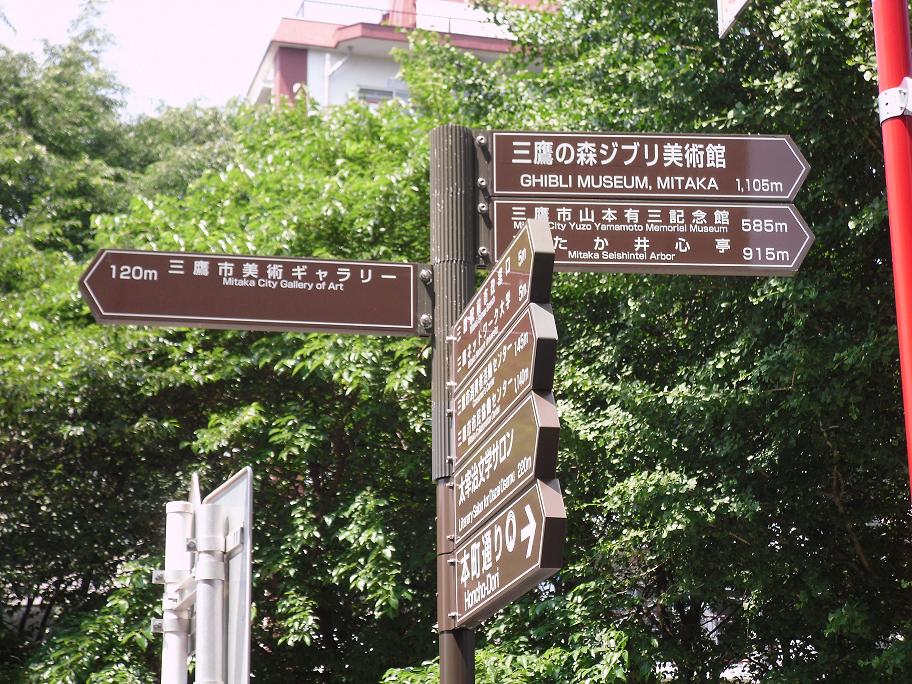
As I started walking towards the museum I crossed the tourist information center which left no doubt as to what their most popular attraction is (The stuffed toy sitting on the chair is a favorite character of one of his movies called Totoro):
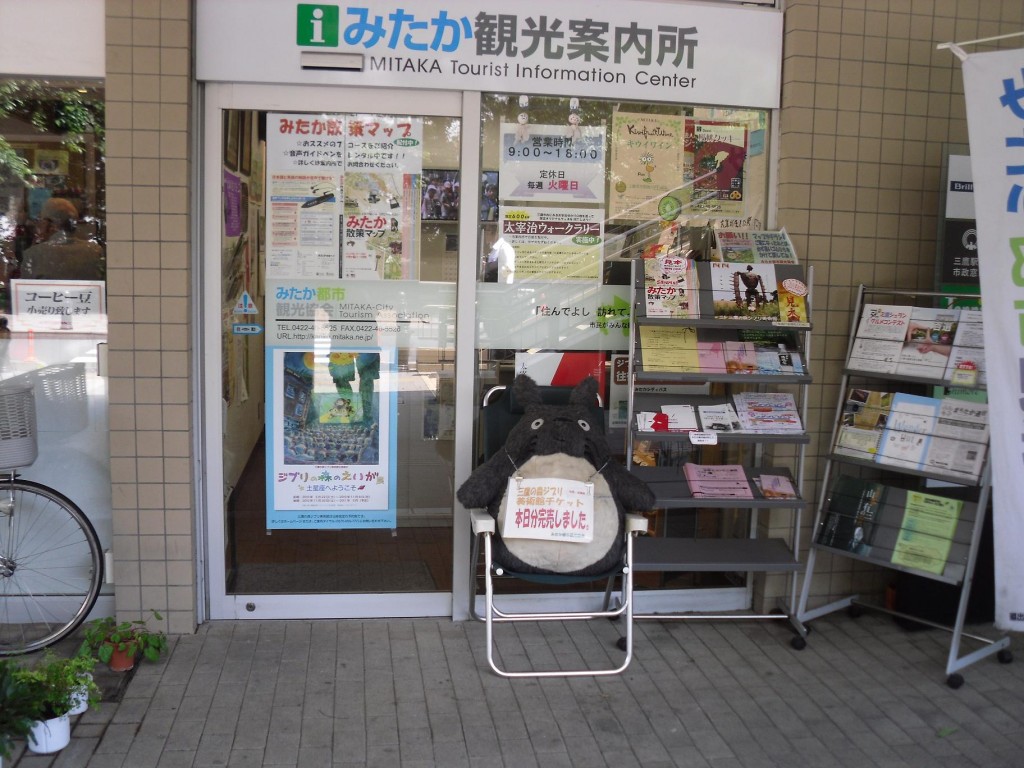
The walk there took about twenty to thrifty minutes and it follows a beautiful stream with lush trees and vegetation. The stream cooled the surrounding air and on a warm and muggy day it was refreshing to walk near it under the shade of the many tree’s. While stopping to snap a few pictures of the stream a local Japanese man tapped me on the shoulder and then pointed to a spot on the river bank. Much to my surprise there was a family of turtles lounging on the side of the small river. A few minutes later a large collection of fish swam up the river ( I over heard an Australian saying he believed that it was Carp).
A little further down there were a pair of birds “kissing” each other repeatedly. I did my best to capture all of this on camera but the fish simply look like large black waves in the stream so you’ll have to take my word for it when I say that they were large and there were several of them. As always you can click on the pictures below for the close up. If you’re in Mitaka a little early it’s really worth walking along the stream! Finally I also included in the set of pictures an old Citroen car and a French restaurant which were along the same path beside the stream.
At the end of he street/stream you had another sign pointing right towards the Ghibli museum and directly in front of you was the park entrance.
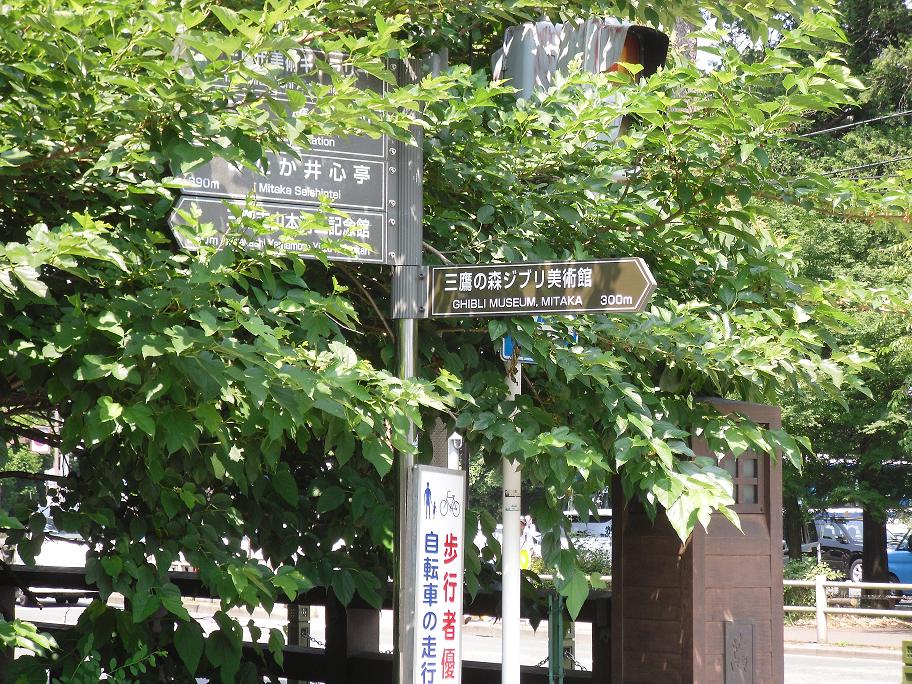
I was running late so I only went into the park on the way back but I highly recommended that walk through the park as it leads to the Ghibli museum. Just keep walking to the right and you wont be able to miss it.
Here was have the entrance to the Museum:
After having entered you were greeted by a friendly attendant:
You’re not allowed to take photos from inside the Ghibli museum. None the less even from the outside you’re able to get a few nice pictures of the museum. Some of the more interesting ones we’re the spiral stairway leading to the roof (one of many!) and one of the sides of the building just before entering. I’ve also included a picture taken from the roof of a young Japanese women in traditional dress. There was actually two of them dressed in this fashion but they were taking pictures of themselves in front of the large Totoro at the entrance of the museum so I was unable to snap a picture of both of them together. I thought the traditional dress was nice. I had seen a monk with something similar asking for donations at the exit of the train station but i didn’t want to take the chance of offending him by taking a picture and my Japanese wasn’t good enough to ask him if it was ok.
One of the many things I enjoyed about the museum is that there is no correct path or order to view the exhibits. You simply wander from one area to the next appreciating and discovering as you go along. Some of my favorite things from this museum in no specific order were:
On the roof was this large statue from the Castle in the sky movie:
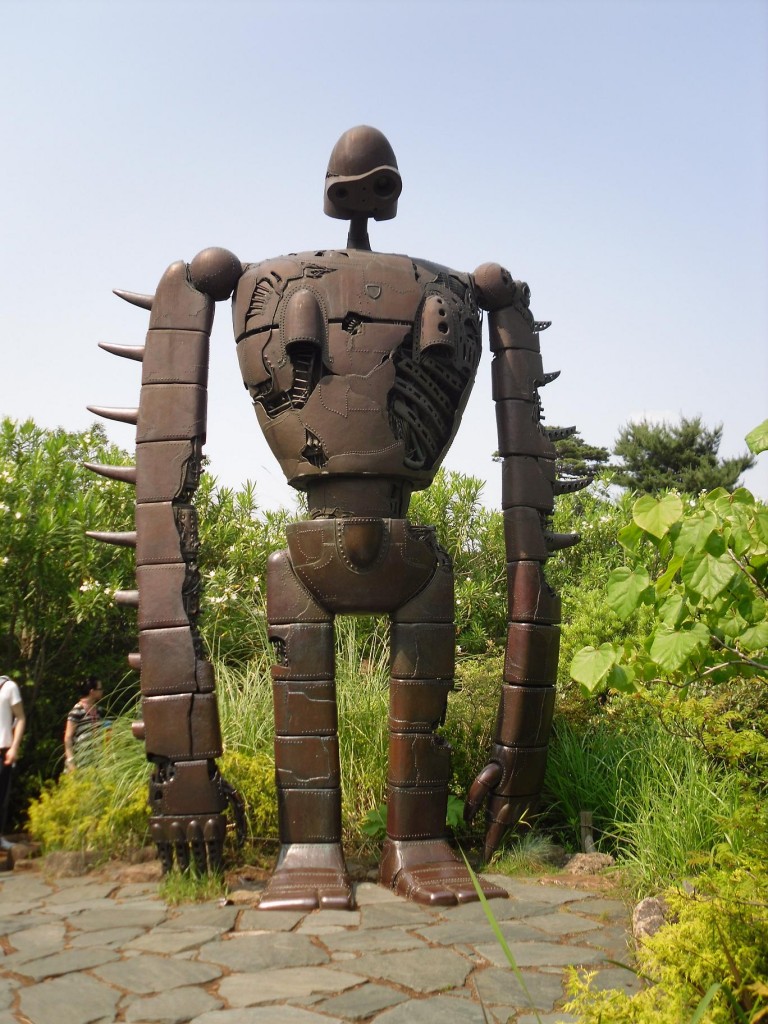
There was also a small cinema inside the museum which played a short animated film that last approximately 15-20 minutes. It was absolutely awesome and even though the voices were in Japanese it wasn’t necessary to understand what they were saying to follow the animation. It was a bout a very old farming couple who had several small white mice living with them. At night the mice would wander off to have sumo wrestling matches against larger mice from another village. Each night they would loose.
One night when the old man followed the white mice and noticed that they were always loosing. The following morning the old man and his wife prepared a large feast of fish, rice balls as well as several other dishes and left them all on small plates and exited the cabin leaving it all to the mice. As night approached the mice with their bellies full went in for yet another sumo match. I don’t want to ruin the rest so I’ll stop here but the animation was absolutely brilliant, funny and heartwarming.
I’ve read that they rotate which small animation plays at the cinema every so often and that you can only view the small movie once (they provide you with a a short piece of the actual film when you walk into the museum and they stamp the cardboard holding in on your way into the theater).
Another one of my favorite exhibits were the ‘old animation’ technique section. It had many old animation machines but my favorite was a large rotating disc (think of a merry go round like disc) with several different cartoon statues on it. The lights would go out and the disc would start spinning. It’s at that point that the ‘cartoon statues’ would come to life and appear to dance. It was truly amazing an lots of people just sat there in awe while this display stopped, started and stopped over and over again. You couldn’t help but wander this museum in a state of childlike happiness. It had spiral stairways going up to each floor, doors that opened to smaller doors that led into tunnels which joined different rooms.
It also showcased what I suspect was Hayao Miyazaki working studio. It was roped off so you couldn’t actually go into the studio but it was still very close so that you could see the desk, the inks, the scrap books and model displays. I felt the museum did a really good job of providing many interactive areas related to animation. You could turn nobs which made movies play (it made sheets of paper quickly rotate and in doing so generated various animations.)
There was one area where I suspect all the fans of Hayao Miyazaki wished that they were still young children. In one of him movies “(My neighbor Totoro”) there’s a large bus which is actually a cat. In the movie in question the cat would open it’s door and would drive around the country side using it’s many feet. Here’s a picture of the cat bus in question:
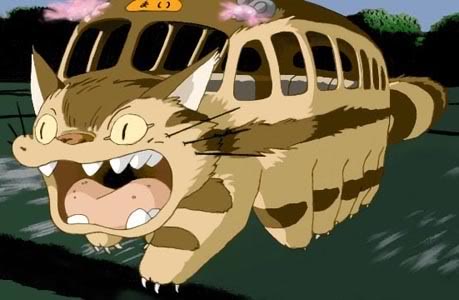
There was an almost life size, furry cat bus in one section of the museum for all the kids to jump on, into and all over. It was refreshing to see all the smiles on the kids as they ran, jumped and bounced all over and inside this thing. If it wasn’t clearly indicated everywhere and in every language that the ‘cat bus’ was for children only I’m sure many of the adults would of joined into the fun. Inside and all around the cat were also the little black dust balls (another character from his movies) which were basically just large furry round critters.

At one point the kids starting collecting all of them and placing them on top of the large cat. It’s a shame that they didn’t allow photo’s inside of the museum because that one would of been priceless. That being said i did find what I suspect to be a promotional picture of the cat bus in question:
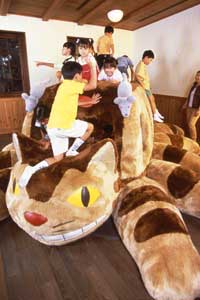
I spent a good few hours in the museum and finally left after visiting one of the gift shops. There were so many interesting and cool things available to purchase. Some of the items I picked up included several postcards with scenes from his movies, some magnetic postcards, a bunch of cut film from the movie “spirited away” as well as many other items.
Most of these will serve as gifts but a lot will be souvenirs from this wonderful place. If you’re in Tokyo and even remotely enjoy animation or are traveling with children do not miss the opportunity to see this fine arts museum!
Finally after having exited the museum I walked through the park on the way back to the metro station. Below you can find a set of pictures from the park, which I wandered for a half hour. It was relaxing to walk along the paths, watching the various Japanese people come and go:


